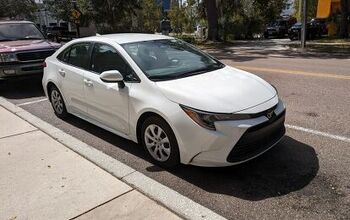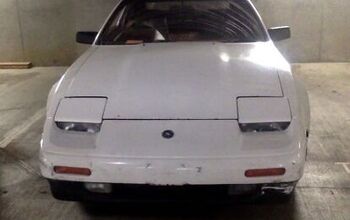2019 Hyundai Santa Fe: Revamped Range-topper Slinks Into Reality

As part of its sales-stimulating crossover offensive, Hyundai’s upcoming Santa Fe will drop the safe styling act that’s carried the model since its inception. The first official images of the 2019 model are out, revealing a three-row vehicle that mimics Hyundai’s smallest crossover, the Kona.
Like that bottom-rung sibling, the 2019 Santa Fe, due for a full reveal ahead of March’s Geneva Motor Show, adopts the brand’s now signature “cascading grille” and a quartet of headlamps — narrow running lights above, driving lights below. Get used to the new face, as you’ll be seeing it on plenty of Hyundai rigs in the coming years.
While we don’t have a full range of specs, we can tell you the next Santa Fe shrinks in overall length (down from 193.1 inches to 187.8 inches), while growing two-tenths of an inch in width. Hyundai promises a wheelbase stretch, which should make for easier loading of rear-seat passengers.
Overall, the new design is miles removed from the current generation. Bland flanks are out, “bold” and “aggressive” is in. In addition to a strong character line bridging the headlights and taillights, the Santa Fe’s flanks see a pronounced lower body ridge, generously swathed in chrome (which never stops screaming “luxury!”) Interesting scalloped arches enliven the boring space around each wheel.
Out back, mystery reigns. That’s because Hyundai’s keeping the Santa Fe’s tail a secret for now, though recent renderings give us a good idea of what to expect.
The most notable change in the vehicle’s cabin is the stand-up multimedia touchscreen, no longer buried in the center stack. We’ve seen this feature crop up on recent Hyundai passenger cars.
Overseas, power comes by way of a turbocharged 2.0-liter four-cylinder (plus a four-banger diesel) in Hyundai’s home country, but U.S. details aren’t forthcoming just yet. Expect the 3.3-liter V6 to make an appearance on uplevel trims, at the very least. In keeping with the times (and its competition), the Santa Fe will need to pay more attention to fuel economy; this could show itself in the form of a smaller base engine or a transmission with more than six cogs.
While styling can carry the day in many segments, Hyundai knows the typical Santa Fe buyer is not a gregarious fratboy in his early 20s. Hence the added safety features. For 2019, Hyundai adds Cross-Traffic Collision-Avoidance Assist and Safety Exit Assist to its SmartSence suite of driver’s aids.
The first feature automatically stops the vehicle if it detects an obstruction while backing up; the latter locks the vehicle’s doors when it senses another vehicle approaching from the rear.
A full list of features and specifications should drop later this month.
[Images: Hyundai]

More by Steph Willems
Latest Car Reviews
Read moreLatest Product Reviews
Read moreRecent Comments
- ToolGuy I was challenged by Tim's incisive opinion, but thankfully Jeff's multiple vanilla truisms have set me straight. Or something. 😉
- ChristianWimmer The body kit modifications ruined it for me.
- ToolGuy "I have my stance -- I won't prejudice the commentariat by sharing it."• Like Tim, I have my opinion and it is perfect and above reproach (as long as I keep it to myself). I would hate to share it with the world and risk having someone critique it. LOL.
- SCE to AUX Sure, give them everything they want, and more. Let them decide how long they keep their jobs and their plant, until both go away.
- SCE to AUX Range only matters if you need more of it - just like towing capacity in trucks.I have a short-range EV and still manage to put 1000 miles/month on it, because the car is perfectly suited to my use case.There is no such thing as one-size-fits all with vehicles.



































Comments
Join the conversation
Not bad. I think all previous Santa Fe styling is better described as "fugly" than "safe" though. Especially the first one.
Is the Safety Exit Assist a different approach of when to trigger auto lock on a vehicle? Or is it intended to deter beggers and stick up boys in the hood?